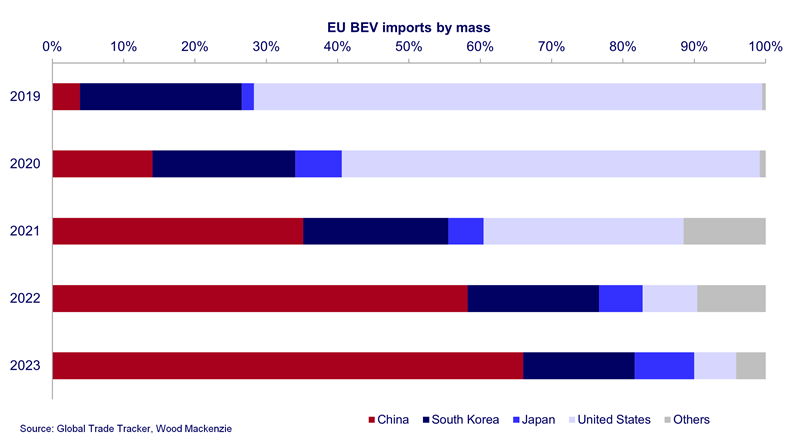Sign up today to get the best of our expert insight in your inbox.
Why higher tariffs on Chinese EVs are a double-edged sword
The many and unintended consequences for decarbonisation and automakers
3 minute read
Simon Flowers
Chairman, Chief Analyst and author of The Edge

Simon Flowers
Chairman, Chief Analyst and author of The Edge
Simon is our Chief Analyst; he provides thought leadership on the trends and innovations shaping the energy industry.
Latest articles by Simon
-
The Edge
A world first: shipping carbon exports for storage
-
The Edge
WoodMac’s Gas, LNG and the Future of Energy conference: five key themes
-
The Edge
Nigeria’s bold strategy to double oil production
-
The Edge
US tariffs – unpredictability is the strategic planners’ nightmare
-
The Edge
US upstream gas sector poised to gain from higher Henry Hub prices
-
The Edge
What comes after the Permian for IOCs?
Max Reid
Principal Analyst, Electric Vehicles & Battery Supply Chain Service

Max Reid
Principal Analyst, Electric Vehicles & Battery Supply Chain Service
Max tracks supply chain developments, technological innovations and progressions in battery demand sectors.
Latest articles by Max
-
The Edge
Why higher tariffs on Chinese EVs are a double-edged sword
-
Featured
EV and battery supply chain 2024 outlook
-
The Edge
Can battery innovation accelerate the energy transition?
The US and EU have slapped big tariff increases on Chinese EVs, responding to the threat of China flooding those regions with low-cost electric vehicles. Restricting EV and battery imports from China not only threatens the pace of road transport decarbonisation in these major markets, but higher tariffs could also negatively impact domestic automakers. I asked Max Reid, Principal Analyst, Battery Supply Chain, for his thoughts.
How did China come to dominate the EV market?
Major US, European and Japanese manufacturers have dominated the supply of global internal combustion engine (ICE) vehicles for a century. EVs are disrupting the status quo, with Western carmakers’ strategies for electrification closely tied to China. Many have doubled down on supply chains dependent on China, specifically those for batteries and specialist electronic technologies.
At the same time, China seized the opportunity to establish its own domestic EV supply chain at scale. Knowledge transfer from joint ventures with Western manufacturers, investment in R&D, production of high-quality batteries and vertical integration have enabled China to deliver the most competitive EVs to the global market. For politicians in the US and the EU, China’s success is a direct consequence of massive government subsidies and unfair advantage.
What’s been the US and EU response?
Hiking import tariffs to cut China’s cost advantage. In the latest of a succession of escalating moves, the Biden administration last month raised US import tariffs on Chinese EVs to 100% from 25%. Tariffs on batteries were also raised to 25% from 7.5%.
The EU in turn announced new tariffs this week. On top of the current 10% duty, Chinese battery EVs will be subject to up to 38.1% in additional duties, depending on the EV brand, from later this year.
Why is Europe more cautious than the US?
The EU is far more dependent on Chinese EVs. The bloc imported 40 times more vehicles from China than the US in 2023, while China’s share of fully electric EVs imported into the EU leapt from 4% in 2019 to 67% last year. Leading automakers – including Tesla, BMW, MG and Volvo – already produce numerous EV models in China for export into the EU, something that shows no sign of slowing as manufacturers expand production hubs to take advantage of lower costs.
The more modest EU tariff increases are a compromise that will allow consumers access to low-cost Chinese EVs while avoiding an exodus of European producers to China. Tariffs on a par with the US would prevent EVs reaching price parity with ICE vehicles and put the EU’s current target of 100% fleet emissions reductions by 2035 out of reach.
Another factor is China’s importance as a major export market for European automakers. The EU can’t jeopardise its potential EV lifeline from Chinese producers for a trade war that could have costly repercussions on domestic manufacturers which sell premium ICE vehicles into China.
What’s the long-term solution?
Tariffs inevitably come with workarounds. The US could find itself indirectly reliant on Chinese imports via made-in-Mexico EVs and batteries. A Mexican EV hub has the appeal of favourable NAFTA tariffs into the US and export markets into Latin America, a priority market for some Chinese automakers.
For the EU’s strategy to develop a competitive EV supply chain at home, low-cost battery manufacturing holds the key. However, European gigafactories have struggled with costs and offtake, and the build-out is yet to match expectations. Consequently, the EU looks increasingly dependent on external investment. With Korean and Japanese cellmakers being lured to North America by lucrative subsidies, China comes into the frame. It’s no slam dunk, as Chinese cellmakers are already well advanced with alternative investment options across Asia and Latin America.
So, at the same time as the EU ups its tariffs on Chinese EVs, paradoxically the bloc may well have to simultaneously offer attractive incentives to lock in China’s battery know-how.
Looking ahead, batteries remain the primary stumbling block for US and EU efforts to completely decouple from Chinese EV supply chains. Cutting off Chinese supplies of spherical graphite and cathode materials could do more harm than good in the near term as gigafactories in both markets will supply only half the batteries needed for domestic EV production by 2030 on Wood Mackenzie forecasts. Most of the shortfall will need to be sourced from China.
The recent tariff hikes send a strong signal that Washington and Brussels are gearing up to challenge China’s EV dominance. But success is likely to come with a hefty price tag.
Make sure you get The Edge
Every week in The Edge, Simon Flowers curates unique insight into the hottest topics in the energy and natural resources world.








